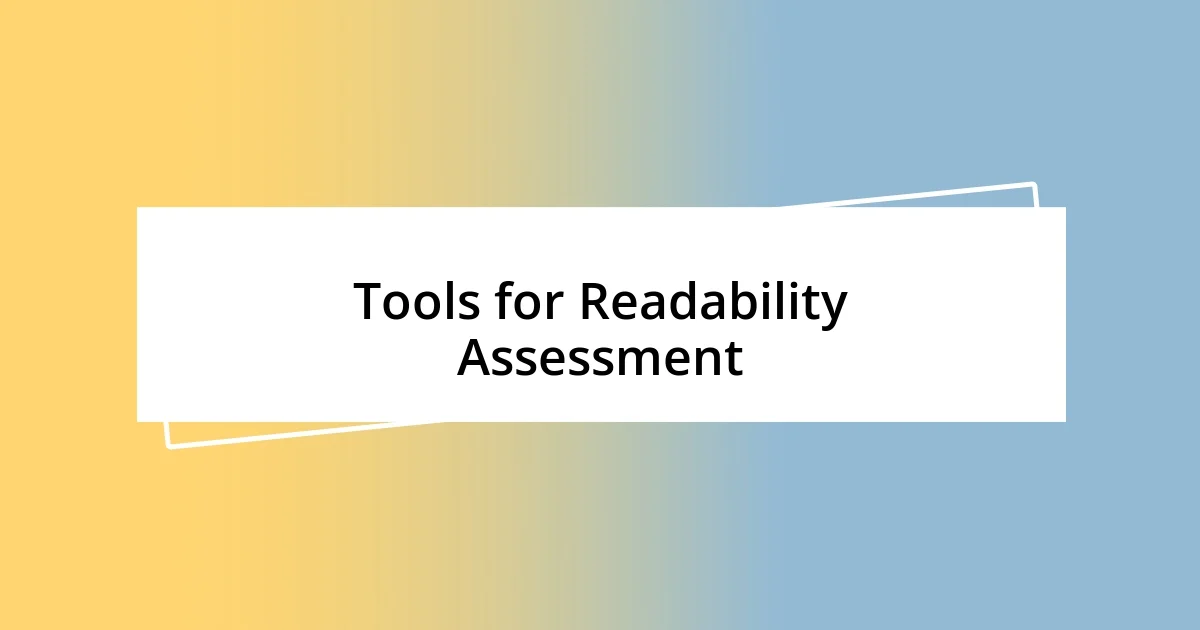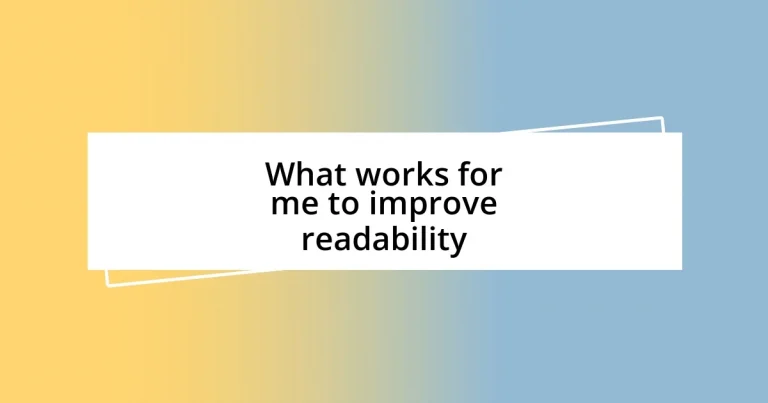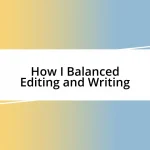Key takeaways:
- Simplifying text through techniques like short sentences, active voice, and eliminating jargon enhances clarity and reader engagement.
- Clear structure with well-placed headings and smooth transitions aids comprehension and guides the reader effectively through the material.
- Incorporating visual elements, such as infographics and bullet points, improves readability and makes complex information more accessible.

Understanding Readability Principles
When I first delved into the principles of readability, I was surprised to learn how much simple adjustments could enhance a text’s clarity. For instance, breaking down complex sentences into shorter, more digestible ones can significantly reduce cognitive load, making it easier for readers to grasp the message. Have you ever found yourself rereading a convoluted paragraph? I know I have, and that frustration motivated me to simplify my own writing style.
One principle that often flies under the radar is the importance of word choice. Choosing familiar, everyday language can be a game-changer in engaging your readers. I remember a time while writing a blog post filled with technical jargon; it felt like my readers were drifting away. Swapping out those complex terms for simpler synonyms not only improved the readability but also drew more people into the conversation.
Visual elements, such as bullet points and headings, play a crucial role in readability, too. Have you ever skimmed through a dense block of text, only to feel overwhelmed? When I started incorporating lists and breaking up my content with visuals, I noticed readers were able to interact with my writing far more effectively. It felt rewarding to watch engagement grow simply by enhancing how information was presented.

Techniques for Simplifying Text
There are various techniques I’ve found helpful for simplifying text, and one of the most effective is eliminating unnecessary words. I used to think that adding more descriptions made my writing sound sophisticated. However, I soon realized that cutting out fluff not only improved clarity but also made my writing more impactful. Just imagine reading a sentence that feels heavy with jargon versus one that’s crisp and straightforward—it’s like taking a breath of fresh air.
Here are some specific strategies that work for me:
- Opt for short sentences: They make it easier to digest information.
- Use active voice: It creates a more direct and engaging tone.
- Limit jargon: When technical terms are necessary, I always explain them.
- Break information into smaller chunks: This helps readers process concepts more easily.
- Use bullet points: They highlight key points and facilitate quick scanning.
- Incorporate analogies: Relating complex ideas to familiar experiences can clarify challenging concepts.

Importance of Clear Structure
Clear structure is essential for readability because it guides the reader through the text. When I layout my thoughts in a logical sequence, it feels like I’m leading the reader on a journey. I remember a time when I wrote an article without a well-defined structure, and my readers expressed confusion about the flow. That’s a moment I learned how critical it is to keep information organized and coherent.
Another important aspect of a clear structure is the use of headings and subheadings. They act like signposts, directing the reader where to focus next. I often find myself moving through content faster when well-placed headings are present. Think about when you’re skimming through an article; those headings help you locate the sections that pique your interest at a glance. Without them, important information might easily be overlooked.
Finally, having a clear beginning, middle, and end allows the reader to form a complete understanding of the topic. Transitioning from one idea to the next should feel natural; I strive to create connections between concepts that are easily identifiable. Once, while revising a lengthy piece, I added transitional phrases and surprised myself with how smoothly the content flowed afterward. It’s these small adjustments that make a significant difference in readability.
| Aspect | Impact on Readability |
|---|---|
| Clear Structure | Guides readers through the text, reducing confusion and enhancing understanding. |
| Use of Headings | Helps readers quickly locate and focus on relevant sections, improving navigation. |
| Logical Flow | Creates a sense of coherence, allowing readers to form complete insights into topics. |

Utilizing Active Voice
Utilizing active voice has been a game-changer in my writing. When I switched from passive construction to active voice, I found my sentences became significantly clearer and more vibrant. For instance, instead of saying “The ball was thrown by him,” I now express it as “He threw the ball.” This subtle change not only brings immediacy to the action but also makes my writing feel more engaging. I can’t help but wonder—doesn’t the directness of active voice invite readers to step right into the action along with me?
I remember the first time I realized the power of active voice in an article I was drafting. Initially, I wrote in a passive manner, and when I reread it, I felt a disconnect. It was like watching a movie with the sound turned off. Once I revamped those passive phrases to active constructions, it felt like the narrative came alive. The energy infused into my writing captivated my audience, sparking more engagement and dialogue in the comments section.
Using active voice creates a connection between the writer and the reader, fostering a sense of involvement. In my experience, when I state “I recommend this course,” rather than “This course is recommended,” it feels like I’m genuinely inviting someone into a shared experience. Isn’t that what we want when communicating? To form that bond and share insights? Transforming how I express ideas has not only impacted my readability but has made my writing feel more like a conversation with friends rather than a dry lecture.

Choosing the Right Vocabulary
Choosing the right vocabulary is essential in making my writing approachable. I often reflect on how the words I choose can either invite readers in or push them away. For instance, I remember writing a piece filled with complex jargon meant for a specialized audience, only to hear that it alienated some readers who wanted to learn but felt lost in the terminology. This experience taught me that simplicity often trumps fancy language, grabbing attention while allowing everyone to participate in the conversation.
Adapting my vocabulary to suit my audience’s understanding is crucial, too. The moment I started considering who I was writing for, everything changed. I began to enjoy crafting my messages—a joy sparked by using relatable language. When I write about tech topics, I try to explain terms like “cloud computing.” Instead of just dropping the term in, I say, “Think of it as storage on the internet, accessible from anywhere.” This approach feels rewarding, as I can see my audience’s eyes light up when those concepts become accessible.
Another tip I’ve embraced is mixing familiar words with a sprinkling of descriptive terms. I love experimenting with vivid vocabulary that draws the reader in. Once, while discussing nature, I described a forest not just as “green” but as “a lush tapestry of emerald shades.” The smiles I received from readers showed that these choices make my writing resonate. Isn’t it wonderful to witness how the right words can evoke emotions and images? Crafting this connection is something I continually strive for in my writing journey.

Incorporating Visual Elements

Incorporating Visual Elements
In my experience, integrating visual elements transforms static text into a more engaging experience. I remember incorporating infographics in my articles; it was like adding the cherry on top of a sundae—suddenly, everything felt more complete. Visuals not only break up the text but help to illustrate complex ideas. For instance, when I wrote about data trends, a simple chart vividly conveyed the information that words alone couldn’t express. Don’t you think seeing the data visually makes it easier to grasp?
Another technique I’ve embraced is using images to complement my narratives. I recall designing a blog post about travel experiences, and pairing my words with picturesque landscape photos. It was so rewarding to see readers respond to both the visuals and the text—they felt transported alongside me! The combination of enticing imagery and descriptive writing creates a multisensory experience. Have you ever noticed how a photo can evoke memories or emotions that words sometimes struggle to capture?
Finally, I’ve started incorporating bullet points and numbered lists where appropriate. It’s fascinating how something as simple as formatting can enhance readability. I once had a lengthy article that seemed daunting until I broke it down into bite-sized pieces. The feedback I received was amazing; many readers mentioned how much easier it was to digest the information. Isn’t it just incredible how thoughtful presentation can make a powerful difference in connecting with our audience?

Tools for Readability Assessment
I’ve found that various readability assessment tools are invaluable in improving my writing. One tool I often use is the Hemingway App, which highlights complex sentences and suggests simpler alternatives. I still recall the first time I entered a piece into it; it felt like a light bulb moment seeing my long-winded thoughts distilled into concise, powerful statements. Have you ever felt overwhelmed by your own writing? This tool can help clarify those moments.
Another gem in my toolbox is the Flesch-Kincaid Readability Test. This tool helps me understand the reading level of my text, allowing me to tailor my writing to suit a broader audience. I remember adjusting my content after discovering it was at a college reading level, while my audience consisted mainly of high school students. I really believe that knowing your audience influences how effectively you communicate. It has been rewarding to see increased engagement after these tweaks because everyone deserves to enjoy and comprehend what I write.
Finally, I’ve recently taken advantage of Google Docs’ built-in tools. The word count and sentence length metrics it provides are simple yet eye-opening. I can’t tell you how many times I’ve reviewed my drafts and noticed the sentence lengths creeping up. Striking that balance between varied lengths keeps readers intrigued and engaged. Have you ever thought about how the rhythm of your writing impacts a reader’s experience? I’ve learned that carving out space for short, punchy sentences can really energize the flow of my writing.














